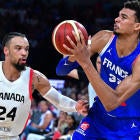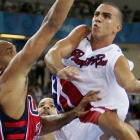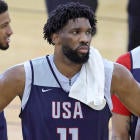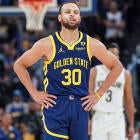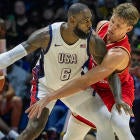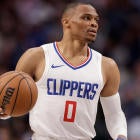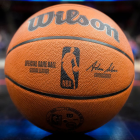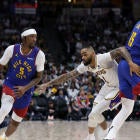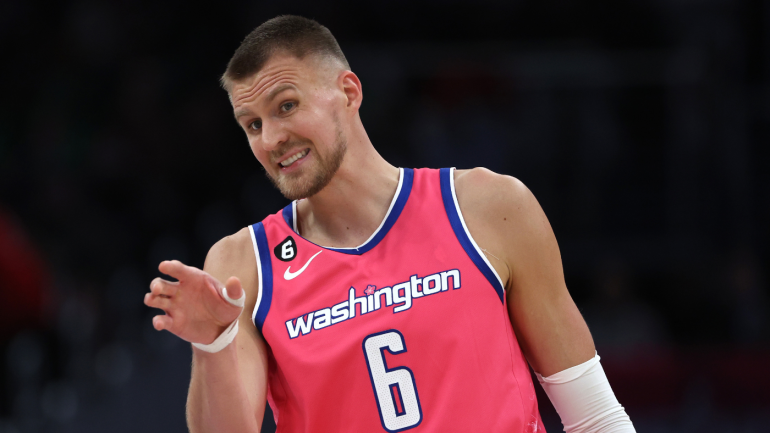
The Boston Celtics nearly pulled off one of the biggest moves of the summer on Wednesday, when reports indicated they were close to a three-way deal with the Washington Wizards and Los Angeles Clippers that would have netted them Kristaps Porzingis. Malcolm Brogdon would have become a Clipper in that scenario, and the Wizards would have gotten Marcus Morris, Amir Coffey, Danilo Gallinari and the No. 30 overall pick in Thursday's draft. But late Wednesday night, an issue with Brogdon's medical reports surfaced leading to the Clippers backing out of the deal.
The Celtics and Wizards could still make a different version of this trade, either independently or with a new third team. In the meantime, below are the grades we assigned to the trade before negotiations fell apart. The principle, at least for Boston and Washington, would remain the same in a two-team deal.
Boston Celtics: C
Let's start with the positives here. Porzingis is coming off of perhaps the best season of his career. He played in 65 games, the most he's participated in since the 2016-17 season. He averaged 23.2 points per game, nearly as many as Boston's entire front-court rotation of Al Horford, Robert Williams III and Grant Williams combined (25.9). He just shot 38.5% from 3-point range on 5.5 attempts per game. Most of the major defensive metrics, including RAPTOR WAR (plus-1.7), EPM (plus-1.2) and defensive real plus-minus (plus-2.72) graded him as a very strong defender last season. Kristaps Porzingis is, in short, a very basketball good player.
The fits on both ends of the floor should be relatively straightforward. Porzingis is a largely stationary rim-protector on defense, which meshes very well with Robert Williams III, who covers much more ground as a weak-side helper. Their fit on offense is similarly strong. Williams wants to dunk. Porzingis wants to shoot. The Celtics have typically eschewed offensive rebounding for the sake of transition defense, but having Williams and Porzingis together should at least drag them closer to league-average. Horford can play alongside just about anyone, though his declining mobility alongside Porzingis could prove more problematic with age.
The argument in favor of this trade for Boston boils down to how stale their offense looked at times in the playoffs. Boston ranked second in the NBA in 3-point attempts per game, but 23rd in points in the paint and 27th in mid-range attempts per game. When it counts, Boston's offense too often boiled down to whether or not the 3's were falling. When they weren't, they had no alternative. A 7-3 center that can shoot from anywhere and score in the post is a nice option to have when nothing else is working. That happens to Boston pretty frequently late in playoff games.
But the negatives are so potentially overwhelming that it's just hard to imagine the rewards outweighing the risks here. Let's start with the obvious financial ramifications. This deal adds around $7 million in salary to Boston's books for this season alone. That has them roughly $8 million below the second apron with 12 players under contract, according to HoopsHype's Yossi Gozlan. That does not include restricted free agent Grant Williams. Boston could theoretically still go above the second apron to re-sign him, but Horford and Robert Williams are still there. How many front-court minutes do the Celtics really have to offer? In that sense, there are two pretty critical elements of this trade that aren't directly part of the deal. Grant Williams is probably gone, and the Celtics likely use the $5 million taxpayer mid-level exception on a perimeter player as a result. Depending on who that player is, this deal could look better or worse.
However, the danger of taking that approach is that Williams was probably the most reliable player in this front court. He's never missed more than nine games in a season. Robert Williams, however, has played in less than 54% of Boston's regular-season games since the Celtics drafted him in 2018 (209 out of 390). He hasn't been at 100% in either of their last two deep playoff runs. Porzingis hasn't been much healthier. Prior to playing 65 games last season, he suited up in only around 58% of his team's regular-season games in the first seven years of his career. Yes, the theoretical fit between these two players is strong, but it's likely to be far more theoretical than practical based on their injury histories. Having Horford around is a nice insurance policy, but he's 37. How much can the Celtics really expect out of him?
And then there are the long-term risks at play. Marc Stein is reporting that Boston is expected to give Porzingis a contract extension in July. Obviously, the dangers of such an extension depend on the actual number, but any extension would keep him in Boston for at least the first season of Jaylen Brown's presumed five-year, $295 million super max contract. If the new Porzingis deal lasts at least two years, he'd be around for the beginning of Jayson Tatum's anticipated $318 million extension. Right now, Porzingis is playing on a max contract. He likely won't be on his next deal, but he isn't coming cheap, either.
This effectively means that Boston is planning to pay three players either max money or close to it right as a new collective bargaining agreement that was designed to punish teams for doing so kicks in. The Celtics seem to have taken the same approach to that CBA that the Suns have: as restricting as the new rules can be, they will ultimately be easier to navigate in the short-term if you are way above the line than if you are under it without a way to add salary. But that approach requires an ownership group that is willing to consistently spend enormous sums of money on luxury tax bills whether or not the team is contending. If Porzingis stays healthy and Boston makes it to the conference finals year in, year out? They can probably justify those expenditures. If not? Keeping a real team together becomes significantly more difficult. If Porzingis gets hurt under an extension, Boston's flexibility is going to be severely limited.
Ultimately, any trade of this magnitude comes with a significant degree of both risk and reward. For the reward to meet the level of risk in this trade, considering where Boston already was and likely would have remained without a deal, the Celtics probably would have needed to become strong championship favorites. That just didn't happen. For everything Porzingis brings to the table, he still doesn't solve their point guard problem. In fact, this trade weakens their backcourt. Brogdon was their best playmaker. Now he is a Clipper, and most of his minutes will likely go to Payton Pritchard, who simply cannot survive defensively in a playoff setting. The Celtics still have wing depth issues as well, and considering the injuries they should expect up front, they likely need at least one more reliable big man.
These are fixable flaws, especially for a team like Boston that still controls its draft capital. But ultimately expecting Boston to fill all of those holes in one offseason and stay completely healthy is just a tad unrealistic. The Celtics were a flawed but flexible team before they made this trade. They remain a flawed team, but have lost a fair bit of financial flexibility after it.
Los Angeles Clippers: B
Hey, speaking of injury risks, the Clippers already had two of the least durable forwards in the NBA... so why not throw a point guard into the mix? Brogdon has played in just under 69% of his team's games across the last six seasons, which is why he fell to the second round of the 2016 NBA Draft in the first place. An arm injury severely limited him against Miami in the Eastern Conference Finals. A plantar fascia tear limited him during his only other deep playoff run with the 2019 Bucks. Considering everything the Clippers have gone through with Paul George and Kawhi Leonard, the thought of adding another glass cannon should scare the Clippers.
But unlike the Celtics, they've absorbed very little risk in this deal. The price was meager: a late first-round pick and Marcus Morris, who fell out of the rotation at the end of last season anyway. Brogdon has two years left on his contract, but Steve Ballmer's wealth is limitless and the Clippers, like the Celtics, seem primed to adopt Mat Ishbia's strategy of essentially ignoring the second apron.
The on-court fit here is strong. The Clippers have tried just about everything to add a traditional point guard. Brogdon is the closest they've ever come to doing so. He is a strong half-court playmaker, but unlike Russell Westbrook, his shooting won't make life harder on his teammates. Brogdon actually led the NBA in 3-point percentage for much of last season, coming in at 44.4% for the year. He's not a strong man-to-man defender anymore, but he's helpful in a team context. The Clippers didn't have the capital to pursue a star point guard like Damian Lillard, but Brogdon should help quite a bit when he's healthy.
The possible presence of Westbrook is actually beneficial where Brogdon is concerned. Westbrook is always healthy, and we know he's perfectly comfortable scaling up in minutes and usage because he's led the league in the latter and likely would in the former as well if his teams would let him. It's no guarantee that the Clippers bring him back, but even if they don't, Terence Mann shined last season when the Clippers played him at point guard, and he could likely take on more ball-handling responsibilities when necessary. In other words, the Clippers have ways of covering for Brogdon when injured, even a postseason absence is less excusable. Considering how little they paid to get him, that makes this a decent trade for them.
Washington Wizards: B-
If you consider Porzingis purely in a vacuum, the Wizards actually came out of their original trade for him in a fairly strong position. They traded two bad contracts to get him, had him for a pretty good year-and-a-half, and then flipped him for one bad contract and a first-round pick, even if it was the last one in the round. That's not bad. Of course, these things don't exist in a vacuum, and the Wizards should've been tanking this entire time, but we can't blame Michael Winger for what happened before he arrived.
It's a somewhat underwhelming return on paper for a player who nearly made the All-Star team last year, though. The odds of finding a reliable rotation player at No. 30 are relatively slim. Coffey is an interesting flier. He just never found reliable minutes with the Clippers, but minutes should be plentiful in Washington. Still, it'd be nice to come away from a trade of this magnitude with at least one relatively stable asset. The Wizards have now traded away their two best players without getting one such piece in return.
Of course, we saw what a Porzingis trade could have looked like with Beal. The Wizards were wise to move off of Porzingis now rather than risking a very dangerous extension that could have rendered him untradeable. There is also value in just getting rid of good players as quickly as possible because it positions Washington for a better draft pick next year. The Wizards won't have to pivot into a tank in February. They're already there. That they didn't take on any extra long-term salary is a nice bonus here. The Wizards didn't get much, but they escaped the middle-of-the-standings purgatory they've been trapped in for almost a decade. That's a win, even if it's a small one.










